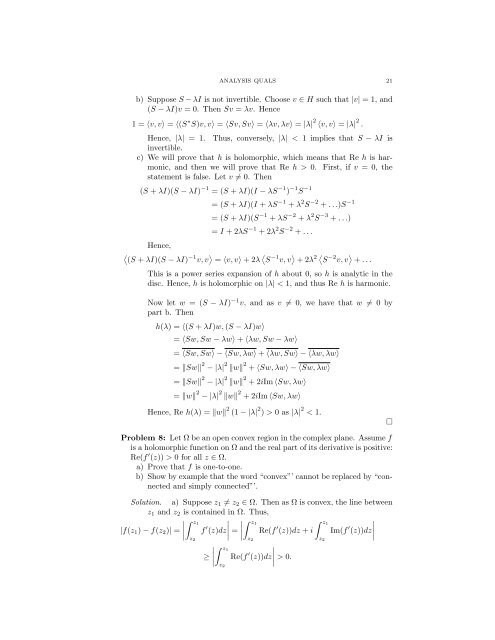ANALYSIS QUALIFYING EXAM PROBLEMS BRIAN LEARY ...
ANALYSIS QUALIFYING EXAM PROBLEMS BRIAN LEARY ...
ANALYSIS QUALIFYING EXAM PROBLEMS BRIAN LEARY ...
Create successful ePaper yourself
Turn your PDF publications into a flip-book with our unique Google optimized e-Paper software.
<strong>ANALYSIS</strong> QUALS 21<br />
b) Suppose S − λI is not invertible. Choose v ∈ H such that |v| = 1, and<br />
(S − λI)v = 0. Then Sv = λv. Hence<br />
1 = 〈v, v〉 = 〈(S ∗ S)v, v〉 = 〈Sv, Sv〉 = 〈λv, λv〉 = |λ| 2 〈v, v〉 = |λ| 2 .<br />
Hence, |λ| = 1. Thus, conversely, |λ| < 1 implies that S − λI is<br />
invertible.<br />
c) We will prove that h is holomorphic, which means that Re h is harmonic,<br />
and then we will prove that Re h > 0. First, if v = 0, the<br />
statement is false. Let v = 0. Then<br />
(S + λI)(S − λI) −1 = (S + λI)(I − λS −1 ) −1 S −1<br />
= (S + λI)(I + λS −1 + λ 2 S −2 + . . .)S −1<br />
= (S + λI)(S −1 + λS −2 + λ 2 S −3 + . . .)<br />
= I + 2λS −1 + 2λ 2 S −2 + . . .<br />
Hence,<br />
(S + λI)(S − λI) −1 v, v = 〈v, v〉 + 2λ S −1 v, v + 2λ 2 S −2 v, v + . . .<br />
This is a power series expansion of h about 0, so h is analytic in the<br />
disc. Hence, h is holomorphic on |λ| < 1, and thus Re h is harmonic.<br />
Now let w = (S − λI) −1 v, and as v = 0, we have that w = 0 by<br />
part b. Then<br />
h(λ) = 〈(S + λI)w, (S − λI)w〉<br />
= 〈Sw, Sw − λw〉 + 〈λw, Sw − λw〉<br />
= 〈Sw, Sw〉 − 〈Sw, λw〉 + 〈λw, Sw〉 − 〈λw, λw〉<br />
= Sw 2 − |λ| 2 w 2 + 〈Sw, λw〉 − 〈Sw, λw〉<br />
= Sw 2 − |λ| 2 w 2 + 2iIm 〈Sw, λw〉<br />
= w 2 − |λ| 2 w 2 + 2iIm 〈Sw, λw〉<br />
Hence, Re h(λ) = w 2 (1 − |λ| 2 ) > 0 as |λ| 2 < 1.<br />
Problem 8: Let Ω be an open convex region in the complex plane. Assume f<br />
is a holomorphic function on Ω and the real part of its derivative is positive:<br />
Re(f ′ (z)) > 0 for all z ∈ Ω.<br />
a) Prove that f is one-to-one.<br />
b) Show by example that the word “convex”’ cannot be replaced by “connected<br />
and simply connected”’.<br />
Solution. a) Suppose z1 = z2 ∈ Ω. Then as Ω is convex, the line between<br />
z1 and z2 is contained in Ω. Thus,<br />
<br />
<br />
z1<br />
z1<br />
<br />
|f(z1) − f(z2)| = <br />
<br />
z2<br />
f ′ <br />
(z)dz<br />
=<br />
<br />
<br />
<br />
<br />
<br />
≥ <br />
<br />
z1<br />
z2<br />
z2<br />
Re(f ′ (z))dz + i<br />
Re(f ′ <br />
<br />
(z))dz<br />
> 0.<br />
z1<br />
z2<br />
Im(f ′ <br />
<br />
(z))dz
















